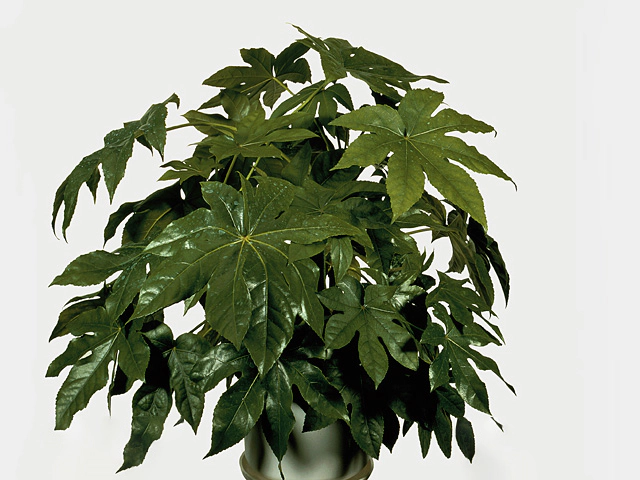Fatsia japonica

| Winter hardness | Limited (USDA-zone 8) |
| Structure (tissues) | Woody |
| Light conditions | Sunny; Semi-shades |
| Leaf division | Simple |
| Plant, growth type | Erect |
| Toxicity (if consumed) | Fairly |
| Moisture requirements | Moist |
Fatsia japonica, commonly known as the Castor Oil Plant, is a versatile and attractive species that thrives in USDA zone 8. Although its winter hardness is limited, it can withstand mild temperatures and fluctuations. This evergreen plant boasts woody tissues, providing it with structural integrity and longevity.
When it comes to light conditions, the Castor Oil Plant prefers sunny or semi-shaded locations. While it can tolerate direct sunlight, partial shade can protect its leaves from scorching in intense heat. This makes it a suitable choice for gardens or landscapes with varying levels of sun exposure.
One notable feature of the Fatsia japonica is its simple leaf division. The large, glossy leaves are palm-shaped and add a tropical touch to any setting. Their deep green color and bold texture make the plant visually appealing year-round.
In terms of growth type, the Castor Oil Plant is erect, reaching an average height of 6 to 10 feet. Its symmetry and upward growth make it an excellent choice as a focal point in gardens or as a background plant in flower beds. With proper care and maintenance, it can form a dense and compact form, serving as a natural screen or hedge.
Despite its many positive attributes, it is essential to note that Fatsia japonica is toxic if consumed. This means it should be kept away from curious pets or small children who may be tempted to nibble on its leaves. However, if precautions are taken, this toxicity should not deter green enthusiasts from adding this plant to their collection.
To flourish, the Castor Oil Plant requires regular watering to maintain moist soil conditions. Periodic watering, especially in hotter months, is crucial to prevent the soil from drying out, which can lead to stress and wilting. Adequate moisture also promotes healthy growth and enhances the plant's overall appearance.
Overall, Fatsia japonica, or the Castor Oil Plant, is a desirable addition to gardens or landscapes in USDA zone 8. Its limited winter hardness should not discourage potential growers, as it can still thrive in moderate climates. With its woody structure, tolerance for varying light conditions, attractive palm-shaped leaves, and erect growth type, this plant add beauty and charm to any setting. As long as its toxicity is acknowledged and moisture requirements are met, the Castor Oil Plant offers an excellent opportunity for plant enthusiasts to enjoy a unique and visually stunning species.
Market availability index by month:
| Jan. | Feb. | Mar. | Apr. | May | Jun. | Jul. | Aug. | Sep. | Oct. | Nov. | Dec. |
|---|---|---|---|---|---|---|---|---|---|---|---|
| 4 | 4 | 3 | 3 | 3 | 2 | 1 | 2 | 3 | 3 | 2 | 2 |